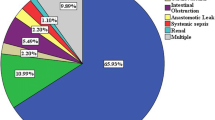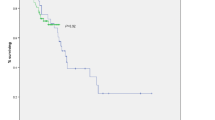Abstract
Background
Epithelial appendiceal neoplasms are uncommon peritoneal malignancies causing a spectrum of disease including pseudomyxoma peritonei (PMP). The optimal management is cytoreductive surgery (CRS) with hyperthermic intraperitoneal chemotherapy (HIPEC). Despite complete CRS (CCRS), recurrence develops in almost 45% of patients. No consensus exists for the optimal treatment of recurrent disease, with treatment strategies including repeat CRS, watch-and-wait, and palliative chemotherapy. This report aims to describe evolving management strategies for a large cohort with recurrence after CCRS.
Methods
This retrospective study analyzed a prospective database of patients with recurrence after CCRS for appendiceal neoplasms from 1994 to 2017 who had long-term follow-up evaluation with tumor markers and computed tomography (CT).
Results
Overall, 430 (37.6%) of 1145 PMP patients experienced recurrence at a median of 19 months. Of these 430 patients 145 (33.7%) underwent repeat CRS, 119 (27.7%) had a watch-and-wait approach, and 119 (27.7%) had palliative chemotherapy. The patients with recurrence had a median overall survival (OS) of 39 months, a 3-year survival of 74.6%, a 5-year survival of 57.4%, and a 10-year survival of 36.5%. In the multivariate analysis, the patients who had recurrence within 1 year after primary CRS (hazard ratio [HR], 3.55), symptoms at recurrence (HR, 3.08), a high grade of disease or adenocarcinoma pathology (HR, 2.94), signet ring cells (HR, 1.91), extraperitoneal metastatic disease (HR, 1.71), or male gender (HR, 1.61) had worse OS. The OS was longer for the patients who had repeat CRS (HR, 0.41). The patients who underwent repeat CCRS had a 3-year OS of 87.5%, a 5-year OS of 78.1%, and a 10-year OS of 67.9%.
Conclusions
Dilemmas persist around the optimal management of patients with recurrence after CRS and HIPEC for appendiceal tumors. Selected patients benefit from repeat CRS, particularly those with favorable tumor biology and focal disease.



Similar content being viewed by others
References
Patrick-Brown T, Carr NJ, Swanson DM, et al. Estimating the prevalence of pseudomyxoma peritonei in Europe using a novel statistical method. Ann Surg Oncol. 2020;28:252–7.
Sharif US, Chandrakumaran K, Dayal S, et al. Mode of presentation in 1070 patients with perforated epithelial appendiceal tumors, predominantly with pseudomyxoma peritonei. Dis Colon Rectum. 2020;63:1257–64.
Sugarbaker PH. Management of peritoneal surface malignancy using intraperitoneal chemotherapy and cytoreductive surgery. A manual for physicians and nurses. Michigan: Luddan Company; 1998.
Ansari N, Chandrakumaran K, Dayal S, et al. Cytoreductive surgery and hyperthermic intraperitoneal chemotherapy in 1000 patients with perforated appendiceal epithelial tumours. Eur J Surg Oncol. 2016;42:1035–41.
Chua TC, Moran BJ, Sugarbaker PH, et al. Early- and long-term outcome data of patients with pseudomyxoma peritonei from appendiceal origin treated by a strategy of cytoreductive surgery and hyperthermic intraperitoneal chemotherapy. J Clin Oncol. 2012;30:2449–56.
Jacquet P, Sugarbaker PH. Clinical research methodologies in diagnosis and staging of patients with peritoneal carcinomatosis. Cancer Treat Res. 1996;82:359–74.
Smeenk RM, Verwaal VJ, Antonini N, et al. Survival analysis of pseudomyxoma peritonei patients treated by cytoreductive surgery and hyperthermic intraperitoneal chemotherapy. Ann Surg. 2007;245:104–9.
Lord AC, Shihab O, Chandrakumaran K, et al. Recurrence and outcome after complete tumour removal and hyperthermic intraperitoneal chemotherapy in 512 patients with pseudomyxoma peritonei from perforated appendiceal mucinous tumours. Eur J Surg Oncol. 2015;41:396–9.
Kyang LS, Alzahrani NA, Alshahrani MS, et al. Early recurrence in peritoneal metastasis of appendiceal neoplasm: Survival and prognostic factors. Eur J Surg Oncol. 2019;45:2392–7.
Mercier F, Dagbert F, Pocard M, et al. Recurrence of pseudomyxoma peritonei after cytoreductive surgery and hyperthermic intraperitoneal chemotherapy. BJS Open. 2019;3:195–202.
Carr NJ, Cecil TD, Mohamed F, et al. A consensus for classification and pathologic reporting of pseudomyxoma peritonei and associated appendiceal neoplasia: the results of the Peritoneal Surface Oncology Group International (PSOGI) modified Delphi process. Am J Surg Pathol. 2016;40:14–26.
Govaerts K, Chandrakumaran K, Carr NJ, et al. Single centre guidelines for radiological follow-up based on 775 patients treated by cytoreductive surgery and HIPEC for appendiceal pseudomyxoma peritonei. Eur J Surg Oncol. 2018;44:1371–7.
Reddy S, Cecil T, Allan P, et al. Extending the indications of intestinal transplantation: modified multivisceral transplantation for end-stage pseudomyxoma peritoneii. Transplantation. 2017;101:S89.
Sardi A, Jimenez WA, Nieroda C, et al. Repeated cytoreductive surgery and hyperthermic intraperitoneal chemotherapy in peritoneal carcinomatosis from appendiceal cancer: analysis of survival outcomes. Eur J Surg Oncol. 2013;39:1207–13.
Tan GHC, Chia CS, Tan SH, et al. Early recurrence after cytoreductive surgery (CRS) and hyperthermic intraperitoneal chemotherapy (HIPEC). Int J Clin Oncol. 2018;23:989–98.
Chua TC, Liauw W, Morris DL. Early recurrence of pseudomyxoma peritonei following treatment failure of cytoreductive surgery and perioperative intraperitoneal chemotherapy is indicative of a poor survival outcome. Int J Colorect Dis. 2012;27:381–9.
Yan TD, Bijelic L, Sugarbaker PH. Critical analysis of treatment failure after complete cytoreductive surgery and perioperative intraperitoneal chemotherapy for peritoneal dissemination from appendiceal mucinous neoplasms. Ann Surg Oncol. 2007;14:2289–99.
Karpes JB, Lansom JD, Alshahrani M, et al. Repeat cytoreductive surgery with or without intraperitoneal chemotherapy for recurrent epithelial appendiceal neoplasms. BJS Open. 2020;4:478–85.
Esquivel J, Sugarbaker PH. Second-look surgery in patients with peritoneal dissemination from appendiceal malignancy: analysis of prognostic factors in 98 patients. Ann Surg. 2001;234:198–205.
Kitai T, Yamanaka K. Repeat cytoreduction and hyperthermic intraperitoneal chemotherapy for recurrent peritoneal carcinomatosis of appendiceal origin. Int J Clin Oncol. 2018;23:298–304.
Kusamura S, Barretta F, Yonemura Y, et al. The role of hyperthermic intraperitoneal chemotherapy in pseudomyxoma peritonei after cytoreductive surgery. JAMA Surg. 2021;156:e206363. https://doi.org/10.1001/jamasurg.2020.6363.
Shapiro JF, Chase JL, Wolff RA, et al. Modern systemic chemotherapy in surgically unresectable neoplasms of appendiceal origin: a single-institution experience. Cancer. 2010;116:316–22.
Eng C, Udell Blackham A, Overman MJ, et al. Systemic chemotherapy in the setting of unresectable appendiceal epithelial neoplasms (AEN). J Clin Oncol. 2012;30:568.
Pietrantonio F, Maggi C, Fanetti G, et al. FOLFOX-4 chemotherapy for patients with unresectable or relapsed peritoneal pseudomyxoma. Oncologist. 2014;19:845–50.
Choe JH, Overman MJ, Fournier KF, et al. Improved survival with anti-VEGF therapy in the treatment of unresectable appendiceal epithelial neoplasms. Ann Surg Oncol. 2015;22:2578–84.
Author information
Authors and Affiliations
Contributions
Conception and design: NA, JG, BM; Acquisition of data: NA, DK, SS, WB; Analysis and interpretation of data: NA, BM, TC, FM, SD, AT; Drafting of article: NA, DK, SS, WB, BM; Critical revision of article: NA, JG, BM, TC, FM, SD, AT
Corresponding author
Ethics declarations
Disclosure
There are no conflicts of interest.
Ethical Approval
Final approval has been given by all authors for the manuscript to be published in the current format.
Additional information
Publisher's Note
Springer Nature remains neutral with regard to jurisdictional claims in published maps and institutional affiliations.
Rights and permissions
About this article
Cite this article
Ahmadi, N., Kostadinov, D., Sakata, S. et al. Managing Recurrent Pseudomyxoma Peritonei in 430 Patients After Complete Cytoreduction and HIPEC: A Dilemma for Patients and Surgeons. Ann Surg Oncol 28, 7809–7820 (2021). https://doi.org/10.1245/s10434-021-10093-z
Received:
Accepted:
Published:
Issue Date:
DOI: https://doi.org/10.1245/s10434-021-10093-z




